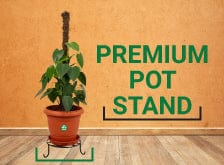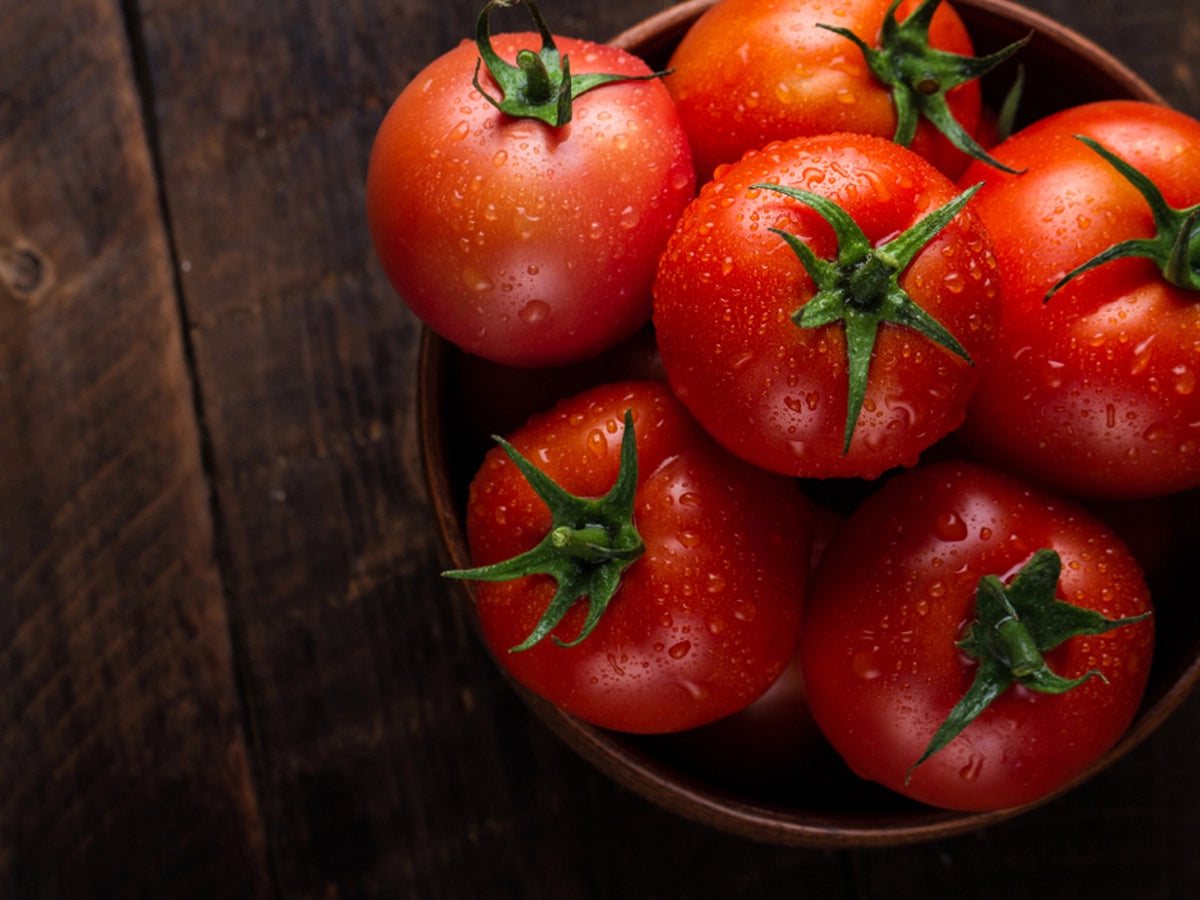How to Grow
Tomatoes are essential – know benefits, growing steps, and care tips
From dips to chips – it is ubiquitous!
Some say it’s a fruit, while some say it’s a vegetable. Then some suggest eating it raw, while others advocate cooking it.
For something that has always been a part of our diet, it is quite a conundrum!
Yes, we are talking about tomatoes – an essential part of all our dishes. Tomatoes add a specific volume to our curries and enhance the color of our foods. As salads, soups, dips, or with momos, parathas (flatbreads), sandwiches, and fritters - tomatoes play quite a role in our gastronomic history.
Tomatoes don’t stop with just a great taste!
They are a storehouse of antioxidants and many powerful nutrients to keep us healthy.
We will discuss how to grow tomatoes at home in this blog. Here’s what we will cover: -
- Interesting facts about tomatoes
- Significant health benefits of tomatoes
- How to grow tomatoes in your home
- How to take care of tomato plants
Let’s dive into the tangy world of tomatoes, then.
Interesting facts about tomatoes
- The scientific name for tomato is Lycopersicon Lycopersicum meaning wolf peach
- Can you believe that there are around 10,000 varieties of tomatoes worldwide?
- Tomatoes originated in western South America, Mexico, and Central America
- In the 16th century, Portuguese explorers brought tomatoes to India. It was grown for the British from the 18th century onward.
- China is the largest producer of tomatoes in the world-beating
- India at second place, contributing to 11% of the total world production of tomatoes
- In India, Andhra Pradesh produces the most tomatoes
- Do you know that 95% of a tomato is water?
Significant health benefits of tomatoes
Eat it in your salad, soup, or in cooked form, tomatoes are meant to be instrumental to your good health. The presence of lycopene which lends the bright red color to them makes tomatoes a nutritious food item. Check the nutritional chart and the probable health benefits of tomatoes below: -
|
Calories |
18 |
|
Carbohydrates |
3.9g |
|
Calcium |
1% of daily recommended value |
|
Fat |
0.2g |
|
Iron |
1% of daily recommended value |
|
Magnesium |
2% of daily recommended value |
|
Potassium |
237mg |
|
Protein |
0.9g |
|
Vitamin A |
16% of daily recommended value |
|
Vitamin B6 |
5% of daily recommended value |
|
Vitamin C |
22% of daily recommended value |
|
Sodium |
5mg |
Boosts immunity
The presence of an antioxidant named lycopene and vitamin C makes tomatoes a great agent to improve your immunity. A robust immune system can ward off plenty of diseases and increase the stamina of your body to recover faster in case you fall sick. These antioxidants fight free radicals and prevent cell damage.
Gifts you a healthy heart
The presence of choline, vitamin C, potassium, and fiber make tomatoes a perfect food for a healthy heart. Avoiding cardiovascular illnesses requires maintaining a high potassium-to-sodium ratio, and tomatoes do just that. The fiber in tomatoes controls blood homocysteine levels, which is a big blessing because higher risks of heart attacks and strokes can result from an elevated homocysteine level. Frequent tomato consumption lowers blood triglycerides and LDL cholesterol, safeguarding us from heart-related disorders.
May prevent cancer
There are plenty of antioxidants alongside vitamin C in tomatoes, and they act against the free radicals that can cause cancer. Polyphenols and beta-carotene are also found in tomatoes, and they are effective in combating cancer.
Aids in digestion
Tomatoes are rich in fiber, giving stools bulk and ensuring their easy passage through the digestive tract. Therefore, you can overcome constipation and related problems by consuming tomatoes. The presence of fiber also aids in the release of gastric and digestive juices and promotes peristaltic motion in the smooth digestive muscles. Therefore, a healthy bowel movement is ensured, and colorectal cancer is also prevented.
Controls high blood pressure
Potassium, a vasodilator that lowers blood pressure, is found in tomatoes. With the consumption of tomatoes, blood circulation increases, which reduces stress on your heart considerably, thus eliminating the chances of hypertension.
A friend for your eyes
A potent antioxidant, vitamin A works to combat the dangerous free radicals that can destroy our eyes. Also, vitamin A protects against macular degeneration, prevents night blindness, and generally enhances our eyesight. Tomatoes also have lutein and zeaxanthin, which may shield your eyes from the blue light produced by digital gadgets like smartphones, laptops, and computers. They might also lessen headaches brought on by eyestrain and keep your eyes from getting weary.
Good for skin and hair
Applying tomatoes directly to the skin can provide instant brightness and remove all signs of tan. Tomatoes can also clear acne, dark spots, fine lines, and wrinkles from your skin, giving it a youthful glow. The presence of vitamins C, A, and E does the trick. Tomatoes are also good for removing dandruff from your hair. It can also help prevent hair fall and promote healthy hair.
How to grow tomatoes in your home
Tomatoes are one of the easiest vegetables that you can grow at home. Here is a complete guide to growing tomatoes at home: -
- The first thing you need to do is choose a variety of tomato that you want to grow. There are broadly two types of tomatoes – bush and vine. If you opt for the vine variety, you need to build a cage, trellis, or stake, and you will get tomatoes all through the year. In this vine variety, you can opt for plum or cherry tomatoes, as they ripen quickly and produce more than the rest.
- Get tomato seeds and a seed starter mix to start the process of planting. Wet the seed starter mix and fill a seedling starter tray with this moist mix.
- Poke a hole in soil in each cell for 1/4th inch depth. Place 3 seeds in each hole with your fingers or tweezers. Cover up with moist soil or mix.
- As you have planted the seeds, cover the seed tray with plastic wrap or a lid, because that will create a warm environment for the seeds to germinate and won’t let the soil dry out.
- Move the seed tray to a warm, sunny location where the temperature is between 21 and 27 degrees Celsius.
- Check the seeds and soil every day and water accordingly. Remember to slightly moisten the soil and not make it soggy.
- The seeds will germinate in 5 to 10 days.
- As you see sprouts on the seeds, remove the cover and feed them with adequate light. Place it on a south facing window or keep the tray under a fluorescent light.
- When you see one to two sets of leaves appear, transplant the seedlings to a larger pot of five to ten gallons.
- Remove the seedlings gently and carefully, and bury them up to the little fuzzy hairs at the base of the plant. These fuzzy hairs will become roots.
- Water right after transplanting the seedling and keep an eye on the soil. Allow the soil to dry out before watering again.
- After two weeks of transplanting, feed the plant with nutrient rich fertilizer. Until the plant reaches maturity, apply fertilizer every two weeks.
- Use a stick, stake, cage, or trellis to offer support to the growing plant. Train your plant from this stage with whichever support you want to use. At this stage, take help of an experienced gardener or watch YouTube videos for the same.
- You are growing the tomatoes indoors, and that means there won’t be bees or birds to help with pollination. You have to assist the plant in this pollination process. Direct a fan towards the plant, which will act like wind. Shake the main stem carefully with your hand so that pollen falls. Then use a paintbrush or cotton swab to rub these pollens on flowers.
After your planting date, count 60-80 days for the tomato vine to produce fruit.
How to take care of tomato plants
Tomato plants are easy to care for. Just follow the instructions mentioned below and enjoy the tangy, red tomatoes.
Sunlight
Tomato plants are thirsty for sunlight. They require 6-8 hours of bright, direct sunlight daily. So, during the cold winter, you can arrange artificial lights to aid the growth and development of these plants.
Location
A south-facing window would be the best location for your tomato plant at home. You can rotate the pot daily until the seedlings flower and produce fruits. If you reside in a warm or hot region, pick an area that receives shade in the late afternoon.
Water
Try to maintain moderately wet but not waterlogged soil. Tomato plants love water but cannot sustain themselves in soggy soil because that leads to damage. The plant can avoid splitting with consistent, thoughtful, and calculated watering. Always check for a one-inch depth of soil before watering. Water only an inch or two every week, but only when the soil dries.
Soil
Tomatoes need soil that is organically rich, well-draining, and slightly acidic to neutral. The soil pH should be between 6.0 and 6.8. For indoor planting, opt for an all-purpose organic potting soil mix.
Fertilizer
Use an organic slow-release fertilizer on your plants since tomatoes are heavy feeders. Tomato plants grown indoors typically require more fertilizer than those produced outside. To ensure greater production, you could need a high-phosphorus fertilizer. Additionally, keep in mind that the soil must be nutrient-rich for tomato plants to survive the entire growing season. Occasionally, you can add manure or compost.
Your diet is incomplete without tomatoes. It will save you some extra bucks when you grow tomatoes inside your home, right? Moreover, the satisfaction of eating something homegrown is unparalleled. So, grow tomatoes in your home today –it’s pretty easy!
FAQs related to Tomatoes
Is it healthy to eat tomatoes every day?
Yes, eating tomatoes every day is a healthy habit. You may eat it in raw or cooked form. Almost all our regular Indian dishes, vegetarian or non-vegetarian, are incomplete without tomatoes. Your body will get essential vitamin C and antioxidants from tomatoes - no matter which form you consume them.
Which is the healthiest way to consume tomatoes – raw or cooked?
Eating tomatoes raw or cooked – is a debatable question. In one experiment conducted by Cornell University scientists, they roasted tomatoes and discovered that as cooking time increased, the vitamin C content of the tomatoes reduced. Compared to raw tomatoes, cooked tomatoes had 10% less vitamin C after 2 minutes of cooking and 29% less after 30 minutes. The lycopene concentration of the tomatoes, however, was the opposite. They had 54% more lycopene after only two minutes of cooking and 164% more after thirty. So, whichever way you consume tomatoes – it will be beneficial for you. You may bring a balance by eating raw tomatoes one day, followed by cooked tomatoes the next day.
How long will it take for my tomatoes to grow?
From the planting day, tomato plants will take at least 60-100 days to harvest, depending on the variety, season, and care you provide.
Is the tomato a perennial plant?
Tomatoes are grown as perennial plants in tropical countries like India, but elsewhere it is mainly grown annually.
Do tomatoes love the sun or shade?
Tomatoes love the sun. It requires at least eight hours of sunshine daily to grow abundantly.
Can tomatoes be grown on a balcony?
Yes, you can grow tomatoes on your balcony easily with the right pot and care guide.





